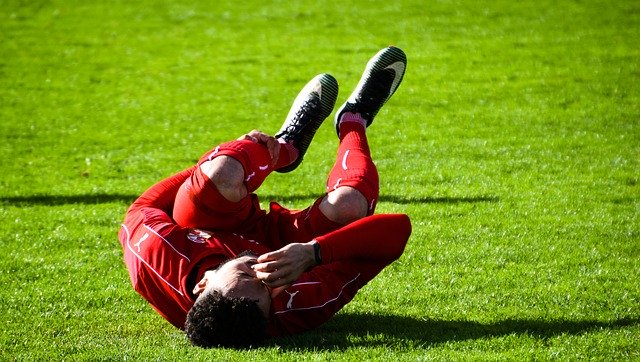Every four years, the World Cup captivates the world, pitting country against country. It leaves one victor. Every four years, however, some soccer players have their dreams dashed when they succumb to injury before the World Cup. Lars Stindl of Germany injured his ankle and was not part of the German team. Argentina’s number one goalkeeper, Sergio Romero, suffered a knee injury and had to bail out of the competition. France took a blow when their defender Laurent Koscielny suffered a torn Achilles. And England lost player Alex Oxlade-Chamberlain to a knee injury.
Injuries in soccer didn’t just happen before the World Cup, though. During the games, injuries took quite a few players down. Colombia’s soccer player, James Rodriguez, suffered a calf injury which forced him out of England-Colombia’s semi-final game. Sime Vrsaljko from Croatia had a knee injury during the semi-final Croatia-Russia game, French soccer player Benjamin Mendy had a thigh injury and England’s John Stones succumbed to a calf injury. With the rigorous training that soccer players go through, injuries can be inevitable. Can sports medicine treat and help prevent these injuries?
What is physiotherapy?
Physiotherapy is a specific area of sports medicine that involves rehabilitation, treatment and prevention of physical injuries. The physiotherapy’s goal is to find the root cause of the injury, treat the pain and build physical strength in order to prevent future injuries.
Pro Fusion Rehab offers physiotherapists for sports injuries, motor vehicle accident injuries, rehabilitation for post-surgery, orthopedic conditions, neurological conditions and more.
What are common soccer injuries?

As there are numerous types of sports injuries, the sports injury treatment will differ. Each treatment is tailored not only to the injury but to the person injured. Here are some of the most common soccer injuries players have suffered and how physiotherapy can help them.
- Ankle Sprain When athletes suffer an ankle sprain, rehabilitation exercises should start as soon as possible to prevent stiffness. Sports injury treatment involves calf stretches and heel stretches. Stretches should be performed frequently within the first 3-10 days. Strengthening exercises after 10 days should include repetitions of front of shin exercises and inner shin exercises. To prevent an injury from reoccurring, both stretching and ankle strengthening exercises must be continued indefinitely. In addition, athletes must wear an ankle brace for a period of 16 weeks or more.
- Hamstring injuries A “pulled hamstring” can range from grade one to grade three. Grade three means the muscle is torn, the athlete is unable to walk and there is a burning pain in the area. Treatment from a physiotherapist should begin as soon as possible and this involves what is known as the POLICE process: protect, optimal loading (where gentle motion is introduced), ice, compression and elevation. Once the initial rest period is over, you can then incorporate stretches and exercises, such as muscle contractions.
- Knee injuries: ACL injuryWhen ligament injuries occur in the knee, the ligament is either stretched or torn. Knee injuries can involve an anterior cruciate ligament tear (ACL injury) or a medial collateral ligament tear (MCL injury). When a knee injury occurs, a physiotherapist will first want to test what kind of injury has occurred. This happens by performing a test, such as the anterior drawer test or the pivot shift test to determine how extensive the ligament injury is. If you can perform some gentle exercises and stretches, knee mobility exercises should be performed. These include knee extensions, hamstring stretches and groin stretches. Strengthening exercises like calf raises and bridge exercises should also be included. Taping the area will also help support the injured area.
- Knee injuries: MCL injuryAdditional ligament injuries occur when the medial collateral ligament is stretched or torn. Severity ranges from a stretch, a partial tear to a complete tear. Once a physiotherapist determines that you have a MCL injury, you will receive immediate treatment which involves applying ice to the affected area, elevating your knee and applying a bandage. When the pain diminishes, gentle stretching and strengthening exercises can then be implemented.
- Shin Splints Shin splints occur when the shins in your lower legs are overloaded. The injury can occur during activities that involve running or excessive jumping. A physiotherapist will recommend immediate treatment like an ice pack. High-impact activity must stop immediately, as well. Exercises like the single leg heel raise and single leg bridge should be performed to strengthen and stretch the area. Prevention measures can include getting new sneakers, strengthening your calf muscles and changing some of your routines that may have led to the injury.
How can soccer injuries be avoided?
- Protective gear: The best preventative measures are wearing adequate protective gear. Soccer players need to ensure that their cleats and shin guards provide strong protection. Footwear is also important. Worn out soccer shoes can cause shin splints.
- Proper stretching: It almost goes without saying that you should stretch before intense periods of training or sports activity. If your muscles feel tight, loosening them up before training can help.
- Strength training: Injuries are liable to happen again if your muscles are not strong. Weak muscles cannot handle impact and will easily succumb to injury.
- Water: As unrelated as it may seem, hydrating your body helps prevent muscle cramps and cartilage problems. Cartilage is made up of 80% water. Going for long spurts without water deprives the cartilage of the water it needs to help your joints.
If you have sustained a sports injury, seek treatment immediately. Pro Fusion offers fully licensed physiotherapists to help rehabilitate and strengthen the injured area through a wide range of techniques.
